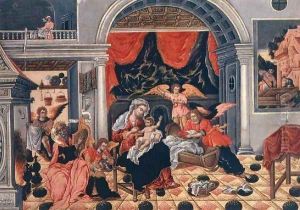Theodoros Poulakis Paintings
Theodoros Poulakis was a distinguished Greek painter, born in 1622 in Chania, Crete, during a period when the island was under Venetian rule. His life and career were profoundly influenced by the turbulent historical context of his time, including the Ottoman conquest of Crete, which led to significant cultural and population shifts in the region. Poulakis's work is emblematic of the Cretan School, a significant movement in post-Byzantine art that blended Byzantine traditions with Western European Renaissance influences, a testament to the complex cultural exchanges of the era.
After the fall of Crete to the Ottomans in 1669, many Cretan artists, including Poulakis, migrated to Venice and other parts of Italy, which became pivotal centers for the Greek diaspora. This migration facilitated the spread of the Cretan School's influence across Europe. Poulakis's art is characterized by its meticulous attention to detail, vibrant use of color, and the harmonious integration of Byzantine and Renaissance elements. His oeuvre primarily consists of religious icons and narrative scenes drawn from the Orthodox Christian tradition, reflecting the deep spiritual and cultural heritage of Byzantine art.
Poulakis is known to have lived and worked in Venice for the majority of his career, where he became an integral part of the local Greek community and its artistic circles. Despite the challenges of living in exile, his work enjoyed considerable acclaim and demand, illustrating the resilience and adaptability of Greek artists in the Diaspora. Theodoros Poulakis died in 1692 in Venice, leaving behind a legacy that has been crucial in understanding the evolution of post-Byzantine art and the enduring cultural connections between the Eastern Mediterranean and Western Europe.
